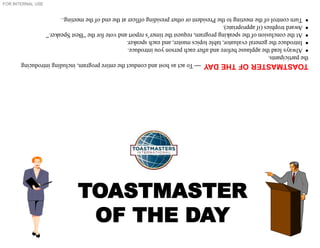TMI Tentcards.ppt
- 1. FOR INTERNAL USE TOASTMASTER OF THE DAY TOASTMASTER OF THE DAY ïū To act as host and conduct the entire program, including introducing the participants. ï· Always lead the applause before and after each person you introduce. ï· Introduce the general evaluator, table topics master, and each speaker. ï· At the conclusion of the speaking program, request the timerâs report and vote for the âBest Speaker.â ï· Award trophies (if appropriate). ï· Turn control of the meeting to the President or other presiding officer at the end of the meeting. .
- 3. FOR INTERNAL USE TOPICS MASTER TOPICS MASTER ïū Responsible for preparing and issuing the topic questions. This portion of the meeting is to provide an opportunity for Toastmasters to learn to âthink and speak on their feetâ and to give everyone in the room an opportunity to speak. Set the stage for your portion of the meeting with brief remarks about the theme or topic. ï· State the maximum time the participant may have for their response (1-2 minutes). ï· State the question briefly, then call on a respondent. (Call on attendees who do not have a speaking role in the meeting first and then those that have lesser roles. After the first or second question, ask any guests present if they would like to participate ï· At the end of your session, ask the timer to report who is eligible for the award (âBest Table Topics Speaker). ï· Ask members to vote for the âBest Table Topics Speakerâ and pass their votes to the Timer/Vote Counter. ï· Return control of the meeting to the Toastmaster .
- 4. FOR INTERNAL USE TIMER VOTE COUNTER TIMER/VOTE COUNTER ïū Responsible for keeping track of time and counting votes for Best Speaker, etc. ï· Explain timing rules and demonstrate how green, yellow, and red visual signals are used. ïPrepared speeches are generally 5 to 7 minutes. GREEN at 5 minutes, YELLOW at 6 minutes, RED at 7 minutes and remains up until the speaker stops speaking. ïTable topics are 1 to 2 minutes. GREEN at 1 minutes, YELLOW at 1-1/2 minutes, RED at 2 minutes and remains up until the speaker stops speaking. ïSpeech evaluations are 2 to 3 minutes. GREEN at 2 minutes, YELLOW at 2-1/2 minutes, RED at 3 minutes and remains up until the speaker stops speaking. âĒ When called upon by the General Evaluator, stand by your chair and give your report. âĒ Provide written results of the Best Speaker, Best Table Topics and Best Evaluator to the Toastmaster of the Day before the end of the meeting
- 6. FOR INTERNAL USE AH COUNTER AH COUNTER ïūPurpose of the ah counter is to note words and sounds used as a âcrutchâ or âpause fillerâ by anyone who speaks during the meeting. Words may be inappropriate interjections such as âand, well, but, you know.â Sounds may be âah, um, er.â Also note when a speaker repeats a word or phrase such as âI,Iâ or This means, this means.â Listen to everyone for âcrutchâ sounds and long pauses used as fillers. Write down how many âcrutchâ sounds or words each person used during the meeting (you may want to state a limit). When called upon by the general evaluator, stand by your chair and give your report.
- 7. FOR INTERNAL USE WORD MASTER WORD MASTER ïū Two basic responsibilities: to introduce a new word to members and to comment on the use of that word during the meeting. ï· Announce the âword of the dayâ, state its part of speech, define it, use it in a sentence, and ask that anyone speaking during any part of the meeting use it. ï· Write down who uses the âword of the dayâ and if it was used correctly or incorrectly. ï· When called upon by the general evaluator, stand by your chair and give your report.
- 10. FOR INTERNAL USE AREA â5â DIRECTOR
- 11. FOR INTERNAL USE DIVISION âBâ DIRECTOR
- 12. FOR INTERNAL USE DISTRICT 116 OFFICIAL
- 13. FOR INTERNAL USE GUEST GUEST Guest Card â Display "NO" side if you do not want to be called on during Table Topics. Display "OK" side if you would like to participate in Table Topics. Guest Card â Display "NO" side if you do not want to be called on during Table Topics. Display "OK" side if you would like to participate in Table Topics.













